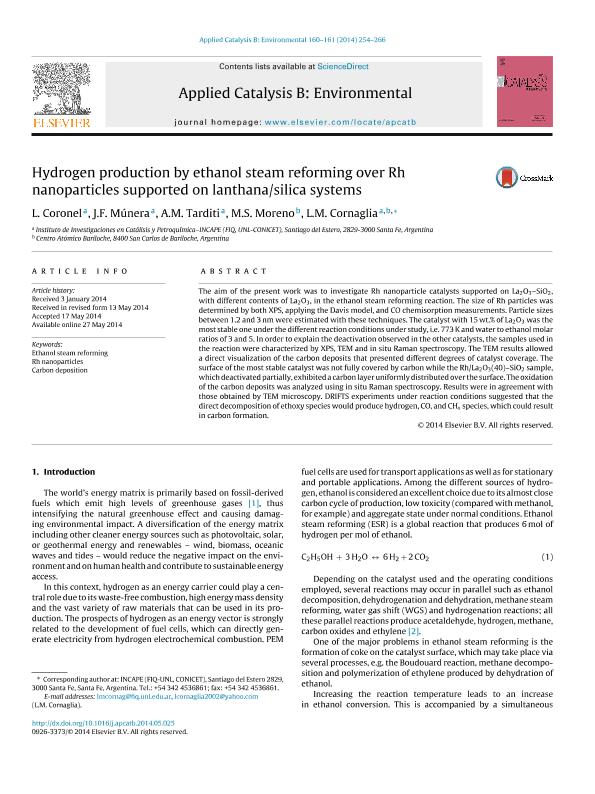Artículo
Hydrogen production by ethanol steam reforming over Rh nanoparticles supported on lanthana/silica systems
Coronel, Leandro ; Múnera Agudelo, John Fernando
; Múnera Agudelo, John Fernando ; Tarditi, Ana Maria
; Tarditi, Ana Maria ; Moreno, Mario Sergio Jesus
; Moreno, Mario Sergio Jesus ; Cornaglia, Laura Maria
; Cornaglia, Laura Maria
 ; Múnera Agudelo, John Fernando
; Múnera Agudelo, John Fernando ; Tarditi, Ana Maria
; Tarditi, Ana Maria ; Moreno, Mario Sergio Jesus
; Moreno, Mario Sergio Jesus ; Cornaglia, Laura Maria
; Cornaglia, Laura Maria
Fecha de publicación:
06/2014
Editorial:
Elsevier Science
Revista:
Applied Catalysis B: Environmental
ISSN:
0926-3373
Idioma:
Inglés
Tipo de recurso:
Artículo publicado
Clasificación temática:
Resumen
The aim of the present work was to investigate Rh nanoparticle catalysts supported on La2O3?SiO2, with different contents of La2O3, in the ethanol steam reforming reaction. The size of Rh particles was determined by both XPS, applying the Davis model, and CO chemisorption measurements. Particle sizes between 1.2 and 3 nm were estimated with these techniques. The catalyst with 15 wt.% of La2O3 was the most stable one under the different reaction conditions under study, i.e. 773 K and water to ethanol molar ratios of 3 and 5. In order to explain the deactivation observed in the other catalysts, the samples used in the reaction were characterized by XPS, TEM and in situ Raman spectroscopy. The TEM results allowed a direct visualization of the carbon deposits that presented different degrees of catalyst coverage. The surface of the most stable catalyst was not fully covered by carbon while the Rh/La2O3(40)?SiO2 sample, which deactivated partially, exhibited a carbon layer uniformly distributed over the surface. The oxidation of the carbon deposits was analyzed using in situ Raman spectroscopy. Results were in agreement with those obtained by TEM microscopy. DRIFTS experiments under reaction conditions suggested that the direct decomposition of ethoxy species would produce hydrogen, CO, and CHx species, which could result in carbon formation.
Palabras clave:
etanol
,
hidrógeno
,
rodio
,
nanoparticulas
Archivos asociados
Licencia
Identificadores
Colecciones
Articulos(CCT - PATAGONIA NORTE)
Articulos de CTRO.CIENTIFICO TECNOL.CONICET - PATAGONIA NORTE
Articulos de CTRO.CIENTIFICO TECNOL.CONICET - PATAGONIA NORTE
Articulos(INCAPE)
Articulos de INST.DE INVEST.EN CATALISIS Y PETROQUIMICA "ING. JOSE MIGUEL PARERA"
Articulos de INST.DE INVEST.EN CATALISIS Y PETROQUIMICA "ING. JOSE MIGUEL PARERA"
Citación
Coronel, Leandro; Múnera Agudelo, John Fernando; Tarditi, Ana Maria; Moreno, Mario Sergio Jesus; Cornaglia, Laura Maria; Hydrogen production by ethanol steam reforming over Rh nanoparticles supported on lanthana/silica systems; Elsevier Science; Applied Catalysis B: Environmental; 160; 6-2014; 254-266
Compartir
Altmétricas



